|
 Hosta 'Sum and Substance' is the
all-time
classic specimen hosta. It forms a giant size (36 inches high by
70 inches wide) clump and is often used as
a focal point plant in the landscape. For many decades it was
thought to be a plant from
Paul Aden of New York who registered it in 1980. Recently, it has been
determined that 'Sum and Substance' was actually originated by
Florence Shaw of Massachusetts.
It is a plant with unidentified parentage but
Field Guide to Hostas by Mark Zilis (2014) states that it is "...possibly a hybrid of 'Bengee' with H.
nigrescens..." Hosta 'Sum and Substance' is the
all-time
classic specimen hosta. It forms a giant size (36 inches high by
70 inches wide) clump and is often used as
a focal point plant in the landscape. For many decades it was
thought to be a plant from
Paul Aden of New York who registered it in 1980. Recently, it has been
determined that 'Sum and Substance' was actually originated by
Florence Shaw of Massachusetts.
It is a plant with unidentified parentage but
Field Guide to Hostas by Mark Zilis (2014) states that it is "...possibly a hybrid of 'Bengee' with H.
nigrescens..."
The leaves are moderately corrugated,
have deeply lobed margins, are cupped both up and down and have a
long, distinct tip. It has thick substance which makes it
resistant to slug damage. From late July into August, it
produces large pale lavender flowers on four foot tall scapes.
 According to
The Hostapedia by
Mark Zilis (2009), this cultivar "...helped shape the
interest in hostas as shade garden plants. It was introduced to the
nursery trade in the early 1980s by Paul Aden and
Klehm Nursery. Once specimens began maturing in gardens in the late 1980s,
gardeners everywhere took notice...Van
Wade of Wade and Gatton Nursery (Closed 2019) of Ohio planted 'Sum and
Substance' in his new collection in 1986, and by 1993. It had reached
a hosta world record of 48" high by 114" wide...hybrids almost
always more closely resemble the other parent...The number of sports
that have been generated out of 'Sum and Substance' has been
staggering..." According to
The Hostapedia by
Mark Zilis (2009), this cultivar "...helped shape the
interest in hostas as shade garden plants. It was introduced to the
nursery trade in the early 1980s by Paul Aden and
Klehm Nursery. Once specimens began maturing in gardens in the late 1980s,
gardeners everywhere took notice...Van
Wade of Wade and Gatton Nursery (Closed 2019) of Ohio planted 'Sum and
Substance' in his new collection in 1986, and by 1993. It had reached
a hosta world record of 48" high by 114" wide...hybrids almost
always more closely resemble the other parent...The number of sports
that have been generated out of 'Sum and Substance' has been
staggering..."
  From the
Field Guide to Hostas by Mark Zilis (2014), "I often wonder where the hosta world would be if 'Sum
and Substance' had never been introduced." From the
Field Guide to Hostas by Mark Zilis (2014), "I often wonder where the hosta world would be if 'Sum
and Substance' had never been introduced."
The New Encyclopedia of Hostas by
Diana
Grenfell (2009) states: "Origin: Unknown but thought to have H. 'Elatior' and H. hypoleuca
in its parentage...Can suffer from stem blight...Selfs (i.e.
self-pollinates) very
easily. It is a fine parent and has produced many sports. A
classic hosta."
 "AHS
multiple award winner: AHS President's Exhibitor Trophy, 1987, exhibited by
Richard Ward; Eunice Fisher Award, 1984; and Midwest Gold Award, 1984, exhibited
by Olive and Joe Langdon, AHS Alex J. Summers Distinguished Merit Hosta, 1990,
selected by Jim Cooper. Plant is a huge cultivar with heavy substance; useful as
a specimen plant. White pruinose on back of leaf. Needs some sun to go from
chartreuse to yellow, so yellowing depends on location." "AHS
multiple award winner: AHS President's Exhibitor Trophy, 1987, exhibited by
Richard Ward; Eunice Fisher Award, 1984; and Midwest Gold Award, 1984, exhibited
by Olive and Joe Langdon, AHS Alex J. Summers Distinguished Merit Hosta, 1990,
selected by Jim Cooper. Plant is a huge cultivar with heavy substance; useful as
a specimen plant. White pruinose on back of leaf. Needs some sun to go from
chartreuse to yellow, so yellowing depends on location."

In an article about hybridizing by
Tony Avent in
The
Hosta Journal (1996 Vol. 27 No. 1), gives the
following comments on cultivars he has introduced: "H. 'Bubba' - fascinating op
(open-pollinated) H. 'Sum and Substance' seedling...very glossy
leaves...bright red neck...unique. Only drawback is sterility...probably due to
abundance of steroids as a child!...H. 'Little Black Scape' -
unique seedling from H. 'Sum and Substance'. Leaves emerge green, but change to
gold about the time that the nearly jet black scape emerges...very
dramatic...not released yet...hopefully soon."

.jpg) Warren I. Pollock in
The
Hosta Journal (1996 Vol. 27 No. 2) states that, "I wrote
about the exciting new sport of 'Sum and Substance' named 'Lady Isobel
Barnett'...The leaves are thick, glossy dark green with an irregular narrow
creamy-yellow margin." Pollock went on to identify other 'Sum and Substance'
sports with similar leaf colors including H. 'David A. Haskell' and H. 'Sum
Total'..." Warren I. Pollock in
The
Hosta Journal (1996 Vol. 27 No. 2) states that, "I wrote
about the exciting new sport of 'Sum and Substance' named 'Lady Isobel
Barnett'...The leaves are thick, glossy dark green with an irregular narrow
creamy-yellow margin." Pollock went on to identify other 'Sum and Substance'
sports with similar leaf colors including H. 'David A. Haskell' and H. 'Sum
Total'..."
Warren I. Pollock in
The
Hosta Journal (2000 Vol. 31 No. 1) wrote that, "H. 'Sum
and Substance' (Aden - 80)...This hosta's magnificence is site-specific, needing
quite a bit of sun to look its best."

In
The
Hosta Journal (2003 Vol. 34 No. 1) Warren I. Pollock adds, "H. 'Sum
and Substance' is believed to be an open-pollinated seedling of H. nigrescens 'Elatior'
and, according to Dr. Ben J.M. Zonneveld, of the
Netherlands it may be a triploid."

Walter Cullerton in
The
Hosta Journal (2010 Vol. 41 No. 1) points out that 'Sum and
Substance' is, "...not
one of my favorite hostas...at a
National
Convention of The
American Hosta Society...I was sitting next to a young
chap from across the pond...He asked me if I liked vase shaped hostas, and I
quickly responded, "Yes, absolutely." He then suggested that I grow 'Sum
and Substance' as a three- to five-crown plant. When I got home, I proceeded to
follow his suggestion and placed the plant in a 10 gallon or so terracotta
planter...Wow! Ever since then, I've kept "ole S&S" in that planer, culling out
several new crowns every spring to maintain the three to five crowns and the
wonderful vase shape."

 A Photo Essay article by hybridizer Steve Chamberlain in
The
Hostta Journal (2010 Vol. 41 No. 1) makes comments about
H. 'Sum and Substance', "...clumps of this cultivar growing in more shade
are the same size at the same age; have fewer, but larger, leaves; and lack the
contested appearance...In addition to genes for heavy substance, large size and
yellow leaves, the unidentified parentage ...includes genes for very dark green,
almost black, leaves which are sometimes expressed in its seedlings. A Photo Essay article by hybridizer Steve Chamberlain in
The
Hostta Journal (2010 Vol. 41 No. 1) makes comments about
H. 'Sum and Substance', "...clumps of this cultivar growing in more shade
are the same size at the same age; have fewer, but larger, leaves; and lack the
contested appearance...In addition to genes for heavy substance, large size and
yellow leaves, the unidentified parentage ...includes genes for very dark green,
almost black, leaves which are sometimes expressed in its seedlings.
...H. 'Leather Sheen, "Mark Zilis and
Doug Lohman registered this cross between the
giant 'Sum and Substance' and the
tiny H. venusta in 1988. In
maturity it makes a spreading carpet reflective of
H. venusta, but with the thick substance of
'Sum and Substance' and dark green, shiny leaves."

An article titled Too Many Lookalikes by
Bob Keller in
The
Hosta Journal (2010 Vol. 41 No. 2) indicates that, "There
are other examples of lookalikes being registered. H. 'Ellerbroek' and 'Fortunei Aureomarginata' are nearly identical in my view, as are 'Antioch' and
'Spinners'. H. 'Patriot' and Minuteman'; 'Great Escape', 'Sleeping
Beauty',
'First Frost' and 'El Nino';
White Bikini' and 'Risky Business' - the list goes
on...H. 'Blue Flame' and 'Secret Love', are both sports of 'Fragrant Blue', are
very similar. There are a host of margined 'Sum and Substance' lookalikes."

 Warren I. Pollock in
The
Hosta Journal (2014 Vol. 45 No. 1) reports that,
"...information from Dr. Kevin C. Vaughn...suggests that H. 'Bengee' likely is
the pollen parent of the popular 'Sum and Substance'. ..What made 'Bengee' so
interesting and desirable in the 1960s, especially to breeders, was it being the
first all-gold 'Tokudama' type." Florence Shaw
used it heavily as a parent," Kevin recalled. Warren I. Pollock in
The
Hosta Journal (2014 Vol. 45 No. 1) reports that,
"...information from Dr. Kevin C. Vaughn...suggests that H. 'Bengee' likely is
the pollen parent of the popular 'Sum and Substance'. ..What made 'Bengee' so
interesting and desirable in the 1960s, especially to breeders, was it being the
first all-gold 'Tokudama' type." Florence Shaw
used it heavily as a parent," Kevin recalled.
...I'm in agreement with what
Bob Solberg...expressed at the 2013 Winter
Scientific Meeting in the Chicago area: "'Sum and Substance' is the second best
name ever for a hosta. Only H. 'Blue Mouse Ears' is better - but just slightly."

An article by Glenn Herold in
The
Hosta Journal (2014 Vol. 45 No. 1) states
that, "Johnson (Greg) crossed H. yingeri with 'Sum and Substance' to get 'Old Coot' and
'Jaz'. Both have good substance and shiny leaves."
This cultivar
has appeared on several of the Popularity Polls by members of
The American Hosta Society
(often at the top of the list - see below). It was the
2004 "Hosta of the Year" by the
American Hosta Growers Association. This cultivar has been awarded the Royal Horticultural Society's
Award of Garden Merit in the
UK.
'Sum and Substance' was winner of the
Benedict
Garden Performance Medal for 2015.
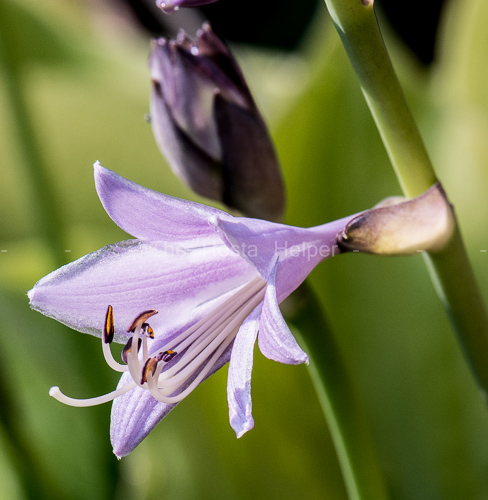



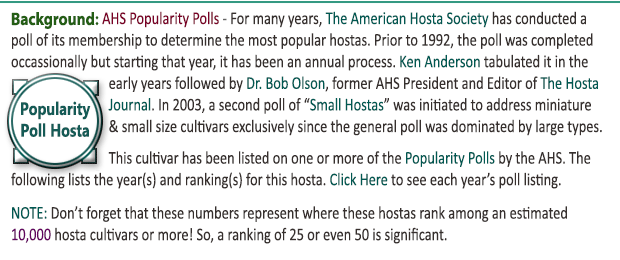 |
 |
 |
 |
| 33 |
4.0 |
1985 #10
1990 #1
1991 #1
1992 #1
1993 #1
1994 #1
1995 #1 |
1996 #1
1997 #1
1998 #1
1999 #2
2000 #2
2001 #1
2002 #3 |
2003 #3
2004 #3
2005 #3
2006 #6
2007 #3
2008 #11
2009 #4 |
2010 #18
2011 #4
2012 #4
2013 #5
2014 #5
2015 #4
2016 #3 |
2017 #6
2018 #3
2019 #5
2020 #9
2021 #8 |
|
|


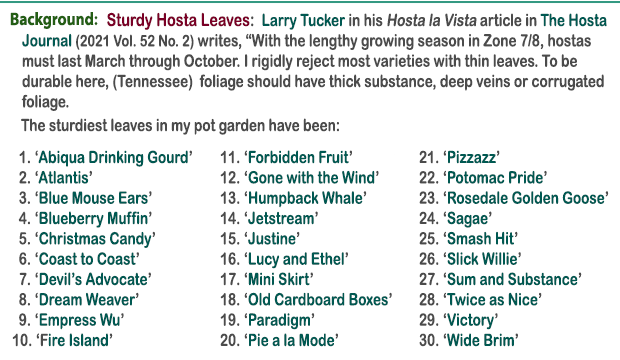



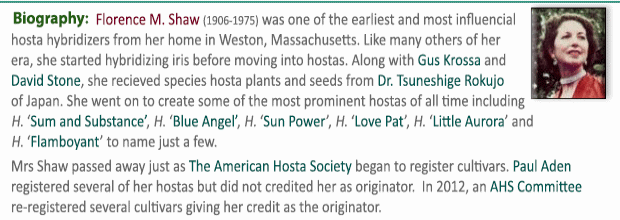
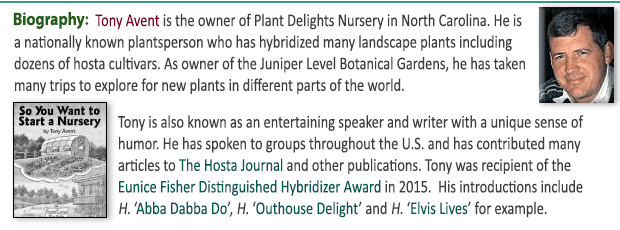



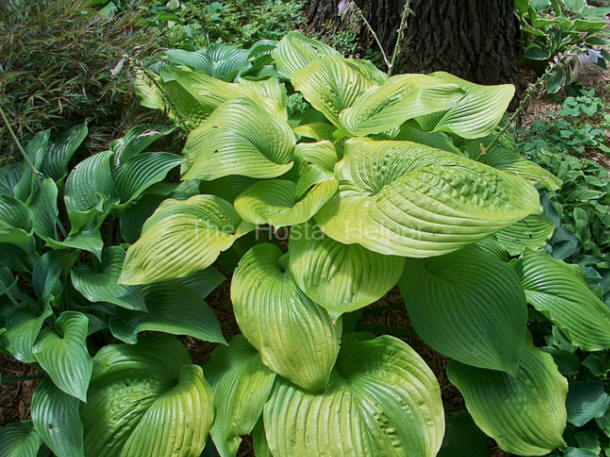











|



